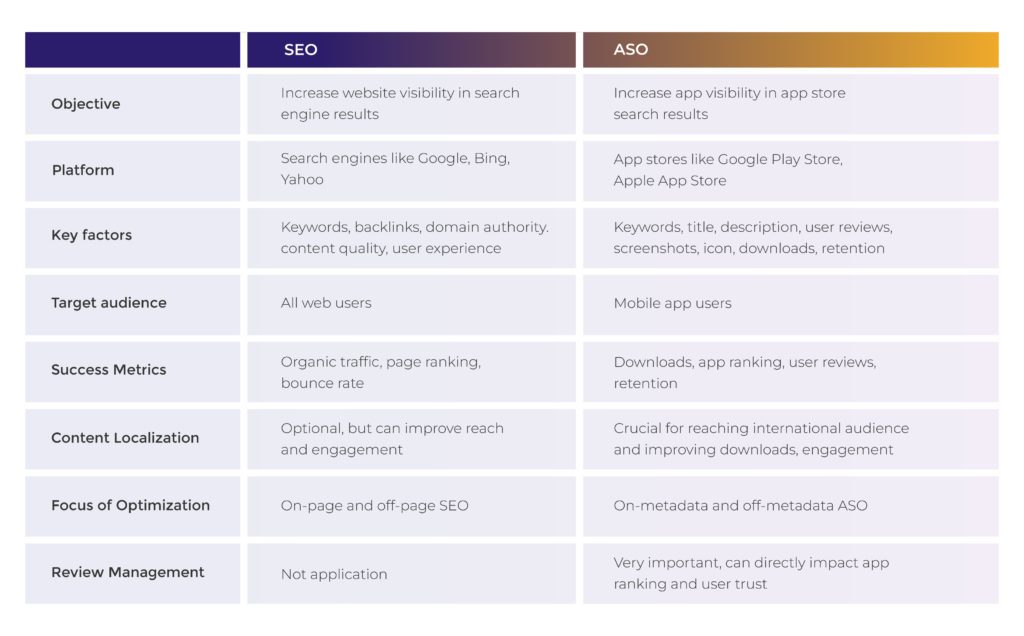It’s not a secret that there are millions of games vying for attention in different app stores. Standing out from the crowd is becoming an increasingly challenging task for mobile game developers. Success in this saturated mobile gaming market will depend not just on creating an engaging game, but on effectively positioning it in app stores where potential players can find and download it. In 2022, the mobile gaming content market was worth an estimated 140.5 billion U.S. dollars, and according to the latest projections, this figure will surpass 173.4 billion by 2026 as mobile adoption and smartphone usage continue to hit new peaks.
Table of Contents
Now, this is where the fun part; App Store Optimization (ASO) comes into play. ASO, similar to its counterpart in web search, Search Engine Optimization (SEO), is a strategy developed to enhance the visibility of mobile apps within app stores. However, it goes beyond SEO by focusing on unique algorithms and user behaviors specific to app stores.
App Store Optimization Infographic
First lets make a quick recap over what’s ASO (App Store Optimization) with this step-by-step Guide to App Store Optimization:

Importance of ASO for Mobile Games
If we view the app market as a human body, ASO would be the nutritious food keeping it healthy and functioning optimally. As a dynamic and developing field, ASO is heavily dependent on strong analytical capabilities and critical thinking to decode app store algorithms and optimize for them. Mobile game developers need to possess analytical skills to gather and interpret data, identify trends, and make data-driven decisions. They must analyze metrics such as app store impressions, click-through rates, conversion rates, and user feedback to understand how their game is performing and make informed optimizations.
Additionally, critical thinking is essential to navigating the ever-changing landscape of app stores, staying ahead of competitors, and adapting strategies to align with the evolving algorithms and user behaviors. By leveraging analytical capabilities and critical thinking, developers can effectively position their games in app stores, increase visibility, drive organic downloads, and ultimately contribute to the commercial success of their mobile games.
ASO: More Than the Sum of Keywords
App Store Optimization is not merely about keyword stuffing or simplistic optimization. It’s a multi-faceted process that takes several important elements into consideration. App icons, user reviews, app screenshots, and localization significantly impact app store performance and visibility. Although SEO and ASO share the common goal of optimization and improved organic visibility, the mechanisms they target are distinct. While SEO caters to search engines like Google, ASO specifically focuses on app stores like Apple’s App Store and Google Play. Here’s a comparison table between SEO (Search Engine Optimization) and ASO (App Store Optimization):


This table highlights some of the key differences and similarities between SEO and ASO. While they share the core objective of increasing visibility in their respective platforms, the strategies and key factors considered in each process are quite distinct.
ASO Ranking Factors for Gaming
1. App Icons
The app icon is the first visual impression users have of your game. A well-designed and visually appealing app icon can attract attention, differentiate your game from competitors, and create a positive brand image. A compelling app icon increases the click-through rate in search results, leading to higher app store visibility and increased downloads.
2. User Reviews
User reviews play a crucial role in app store performance. Positive reviews not only influence potential users’ decisions to download your game but also contribute to higher app store rankings. Engaging with user reviews, addressing concerns, and actively managing your reputation can help build trust, encourage positive reviews, and improve app store visibility.
3. App Screenshots
App screenshots provide visual representations of your game’s gameplay, features, and overall experience. High-quality screenshots that accurately depict the game can capture the interest of potential users and entice them to explore further. Strategic use of screenshots can showcase unique selling points, highlight exciting moments, and effectively communicate the value proposition of your game.
4. Localization
Localization involves adapting your game to specific languages, cultures, and regions. By translating not only the game content but also the metadata such as the title, description, and screenshots, you can improve your game’s discoverability and appeal to a broader international audience. Localization enhances user experience, as users are more likely to engage with an app that aligns with their language and cultural preferences. It can significantly increase downloads, improve app store rankings, and generate higher revenue.
App Store Search Ranking Factors for Gaming
The algorithms that power app stores are the unseen forces driving app visibility. User-driven search queries, the intent behind those queries, the game name, and the description are all critical factors that these algorithms take into account. Understanding these algorithms and aligning your game’s ASO strategy with them is key to improving your game’s ranking.
Importance of the Mobile Game Name
The name of a mobile game plays a significant role in its success and its ability to stand out in a highly saturated market. The game title impacts on its discoverability, branding, and user perception.
Impact on App Ranking
The game title heavily influences the app’s ranking in the app store search results. Both Apple’s App Store and Google Play Store use the game’s title as one of the key factors in their search algorithms. Games with a title that includes keywords related to the game’s content are more likely to appear in relevant search results. For example, “Clash of Clans”, a popular strategy game, includes the keyword “clash”, which is associated with battles and fighting, a central element of the game.
Why is a Mobile Game Name Crucial for ASO?
The game title is a fundamental element of your game’s brand identity. It is the primary way users will refer to and recognize your game. A well-chosen and memorable game name can contribute to building a strong brand image, fostering recognition, and creating a lasting impression among players. Consistency in branding across different platforms and marketing channels can further enhance brand recognition and recall.
Tips for Choosing an Effective Game Title
- Relevance: Ensure that your game title is relevant to the game’s content. This helps set the right expectations for potential players and makes it easier for them to find your game when searching for a specific genre or type of game.
- User perception: The game title sets the initial expectations and impressions for potential players. It provides a glimpse into the genre, theme, or gameplay experience. A descriptive and engaging game title can pique the curiosity of users and generate interest in exploring your game further. Conversely, a poorly chosen or misleading title may lead to confusion or disappointment, affecting user perception and potentially hindering downloads and user engagement.
- Simplicity: Keep the game title simple and easy to remember. Avoid using complicated words or phrases that might be hard for users to recall or spell.
- Keywords: Include keywords that are relevant to your game and commonly used by your target audience in search queries. But, don’t overstuff the title with keywords as this can make the title unreadable and negatively impact user perception.
Considering the branding and user perception aspects of a game title is crucial in crafting an effective and impactful name for your mobile game. It should accurately reflect the game’s content, resonate with the target audience, and align with your desired brand image. A well-thought-out game title can enhance your game’s overall appeal, generate positive user perception, and contribute to long-term success in the competitive mobile gaming industry.
Examples of Effective Game Names
Angry Birds


This game title is simple, memorable, and gives a hint about the game’s content (birds that are angry). It is also unique, helping it stand out in search results.
Subway Surfers


Plants vs. Zombies


The title directly describes the game’s main concept, creating intrigue and setting clear expectations about the game’s content.
Clash Royale


The game title is unique, easy to remember, and includes a relevant keyword (“clash”). It also ties in with the game’s predecessor, “Clash of Clans”, creating a brand association.
Crafting a Mobile Game Description for ASO
The description of your mobile game is a vital part of your App Store Optimization (ASO) strategy. It not only influences your game’s search ranking in the app store but also plays a crucial role in convincing potential players to download your game. Guidelines for an effective game description:
- Start with a Strong Opening: The first few lines of your description are the most critical as they appear before the “Read More” cut-off in the app stores. Therefore, it’s essential to immediately communicate what your game is about and why it’s unique.
- Use Relevant Keywords: Include relevant keywords in your description to improve your game’s visibility in app store search results. However, make sure to use keywords naturally and avoid keyword stuffing as it can negatively impact the readability of your description and the user experience.
- Highlight Key Features: Clearly outline the main features and unique selling points of your game. What makes your game different from others in the same genre? What exciting features does it offer? This information can help potential players understand your game and persuade them to download it.
- Include Social Proof: If your game has won any awards or received positive reviews, mention these in your description. Social proof can help build trust and credibility for your game.
- Have a Clear Call-to-Action: End your description with a clear call-to-action (CTA), encouraging users to download and try your game.
- Keep it Updated: Make sure to regularly update your game description, particularly when you release new features, updates, or expansions.
Examples of Effective Game Descriptions
Clash Royale


Among Us


Remember, writing an effective game description is a blend of marketing, creative writing, and SEO. It’s crucial to balance these elements to create a game description that is not only engaging and persuasive but also helps improve your game’s search visibility.
ASO Keyword Research for Gaming
Conducting keyword research for mobile games follows the same basic principles, but with a focus on terms and phrases that are relevant to the gaming industry. Here’s a step-by-step guide specifically for mobile game developers:
Understand your niche
Start by understanding the genre and sub-genre of your game. Is it a puzzle game? An RPG? A strategy game? An idle game? The more accurately you can describe your game’s genre, the better you can identify potential keywords.
Brainstorm initial keywords
Jot down all the words and phrases that come to mind when you think about your game. Include terms related to the gameplay, setting, characters, and unique selling points. For example, if your game is a fantasy RPG with dragons, you might start with keywords like “dragon”, “fantasy”, “RPG”, “adventure”, etc.
Use keyword research tools
Use tools like AppTweak, SensorTower, or Mobile Action for app-specific keyword suggestions. These tools will help you find keywords related to your initial list and give you insights into search volume, competition, and difficulty.
Study your competitors
Look at similar games in your genre and see what keywords they’re using and ranking for. If “Clash of Clans” is a competitor, for example, you might find keywords like “strategy”, “clan wars”, “base building”, etc.
Consider long-tail keywords
Long-tail keywords are especially important in the gaming industry, where users often search for specific features or gameplay mechanics. For example, instead of just “puzzle game”, you might consider “3D puzzle game with physics” or “multiplayer puzzle game with leaderboards”.
Prioritize your keywords
Once you have a long list of keywords, prioritize them based on relevance to your game, search volume, and competition. You might find that “RPG” has a high search volume but also high competition, while “dragon RPG” has lower volume but also lower competition.
Remember: Test and analyze your keywords
Finally, implement your keywords in your game’s title, description, and other metadata, then monitor your game’s performance. Use your analytics to see how these keywords affect your rankings and downloads, and adjust your strategy as necessary.
Remember, keyword research is an ongoing process. As new games are released and trends change, the effectiveness of your keywords will change as well. Regularly revisit your keyword strategy to ensure it remains effective.
Want to optimize your App Store Promo Video?
The optimization of app preview videos is essential to maximize their impact on app store conversions. Here are some key considerations for optimizing app store promo videos:
1. Duration
App preview videos should be concise and engaging to capture the attention of potential users. Keep the video duration between 15 to 30 seconds, focusing on showcasing the most compelling aspects of your game. Avoid making the video too long, as it may lead to user disinterest or abandonment.
2. Content Selection
Choose the most exciting and visually appealing gameplay moments to feature in your app preview video. Highlight key features, unique selling points, and the overall gameplay experience that sets your game apart. The content should provide a clear representation of the game’s mechanics, graphics, and overall quality. Emphasize the aspects that make your game enjoyable and showcase its potential to captivate users.
3. Visual Appeal
Ensure that the visuals in your app preview video are high-quality, visually stunning, and representative of the actual in-game experience. Use attractive graphics, animations, and effects to enhance the visual appeal and create a positive impression. The video should convey the overall aesthetics and art style of your game to attract users who resonate with those visual elements.
4. Annotations
Annotations in the app preview video can be used strategically to highlight important features or calls to action. Incorporate text overlays or graphics that provide additional information about key gameplay mechanics, rewards, or unique aspects of your game. Annotations can also be utilized to guide users’ attention to specific elements or create a sense of urgency to download or try the game.
5. Call-to-Action
Conclude the app preview video with a clear and compelling call-to-action. Encourage users to download or install the game by including text or voice-over prompts such as “Download now” or “Get it today.” The call-to-action should be prominent and visually appealing, driving users to take the desired action after watching the video.
6. Continuous Testing and Iteration
Don’t hesitate to experiment with different versions of your app preview video to identify what resonates best with your target audience. Test variations in content, visuals, duration, and annotations to determine which combinations drive higher conversion rates. You should always analyze user behavior, engagement metrics, and conversion data to make data-driven decisions and optimize your video over time.
By optimizing your app preview videos for duration, content selection, visual appeal, annotations, and incorporating effective calls-to-action, you can create compelling and persuasive videos that capture users’ attention, showcase your game’s highlights, and drive app store conversions. Lastly, you should continously analyze the performance of your videos and iterate based on user feedback and data to continuously improve their effectiveness.
Why you should localize ASO for your mobile gaming app
The role of localization in App Store Optimization (ASO) is crucial for reaching and engaging users in different regions and languages. Localization involves adapting your app to meet the language, cultural, and other requirements of a specific country or region.
Here are the specific steps involved in localizing your game:
1. Language Translation
The first and most important step in localization is translating the app’s content into the target language (remember, there’s a difference between localization and translation). This includes translating the app’s title, description, user interface, in-game text, notifications, and any other textual elements. Hiring professional translators who are native speakers of the target language is essential to ensure accurate and high-quality translations.
2. Cultural Adaptation
Localization goes beyond translation. It requires cultural adaptation to cater to the preferences and cultural norms of the target audience. This involves modifying the app’s content, visuals, and user experience to align with the target culture. It may include adapting imagery, icons, colors, symbols, and even changing certain features or functionalities to better resonate with the cultural context.
3. App Store Metadata
Localizing the app’s metadata, including the title, subtitle, keywords, and description, is crucial for improving app store visibility in the target market. Each localized version should be optimized with relevant keywords and phrases that users commonly search for in the specific language and region.
4. Visual Localization
In addition to textual localization, consider adapting visuals such as screenshots, app icons, promotional banners, and videos to cater to the preferences and aesthetics of the target audience. This may involve using culturally appropriate imagery, adapting text overlays, or incorporating localized characters or symbols.
5. Date, Time, and Currency Formats
Adjusting date, time, and currency formats to match the conventions of the target region is important for providing a seamless and familiar experience for users. Adapting these formats ensures that users can easily understand and interact with the app’s content.
6. User Support and Communication
Providing localized customer support and communication channels can greatly enhance the user experience. Offering support in the target language, providing localized FAQs or help documentation, and responding to user inquiries promptly and effectively in the local language can build trust and improve user satisfaction.
7. Testing and Quality Assurance
It is crucial to thoroughly test the localized version of your app to ensure that all elements are accurately translated, function properly, and provide a seamless user experience. Conducting usability tests with users from the target market can help identify any issues or areas for improvement.
By following these steps and ensuring comprehensive localization, you can enhance the visibility, usability, and appeal of your app to users in different regions. Effective localization demonstrates a commitment to understanding and respecting the cultural nuances and preferences of your target audience, leading to increased downloads, user engagement, and revenue in specific markets.
Summarizing ASO for Gaming
App Store Optimization is a vital process for any mobile game developer looking to drive organic traffic and thrive in the competitive app market. It’s an ongoing process that requires constant testing, iterating, and optimization. Given the dynamic nature of app stores and user behaviors, there’s no definitive ‘one-size-fits-all’ ASO strategy. However, armed with the understanding of key ASO principles and practices, you’re now better equipped to navigate this landscape. As you continue on your ASO journey, remember to not shy away from experimenting and split testing different elements of your game’s app store presence. Should you have any questions or require further assistance, feel free to reach out to our team at Admiral. After all, your game’s success is our success.






